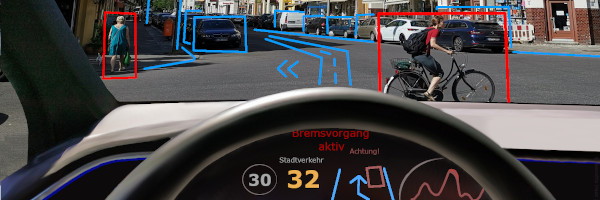Connected Vehicles: Difference between revisions
No edit summary |
No edit summary |
||
| (2 intermediate revisions by the same user not shown) | |||
| Line 1: | Line 1: | ||
{{Chapter | {{Chapter | ||
| | |image=ConnectedChapter.jpg | ||
| | |poc=Wilfred Pinfold | ||
| authors = Wilfred Pinfold, Skip Newberry, Jeff Allen, Ken Montler, Timothy Smith, Joe Cortright, Greta Knappenberger, Jill Sorensen, John Feo, Corey Marshall, Jose Gonzalez, Geoffrey Urbach | |authors=Wilfred Pinfold, Skip Newberry, Jeff Allen, Ken Montler, Timothy Smith, Joe Cortright, Greta Knappenberger, Jill Sorensen, John Feo, Corey Marshall, Jose Gonzalez, Geoffrey Urbach | ||
| | |blueprint=Transportation | ||
| email = wilfred.pinfold@opencommons.org | |sectors=Transportation | ||
| document = TransportationBlueprintFeb18.pdf | |summary=Connected urban speed electric AVs can operate without traffic signals. They can synchronize their behavior through vehicle-to-vehicle (V2V) communications at junctions and can operate at safe speeds that change by location and road conditions. Vehicle-to-infrastructure (V2I) communications can be used to | ||
| chapter = 5007 | activate street lights, get updated route information, open doors, and receive scheduling information. | ||
|email=wilfred.pinfold@opencommons.org | |||
|document=TransportationBlueprintFeb18.pdf | |||
|chapter=5007 | |||
}} | }} | ||
As a citizen moves through a city they interact with city services, transit, schools, parks, and shops. Each of these interactions contains information | As a citizen moves through a city they interact with city services, transit, schools, parks, and shops. Each of these interactions contains information | ||
that can be used to deliver better services. In a smart city each interaction creates a digital transaction informing both the citizen and the city service | that can be used to deliver better services. In a smart city each interaction creates a digital transaction informing both the citizen and the city service | ||
Latest revision as of 06:40, January 22, 2024
| Transportation | |||||||||||
|---|---|---|---|---|---|---|---|---|---|---|---|

| |||||||||||
| Sectors | Transportation | ||||||||||
| Contact | Wilfred Pinfold | ||||||||||
| Topics |
| ||||||||||
Activities
| |||||||||||
- Authors
Connected urban speed electric AVs can operate without traffic signals. They can synchronize their behavior through vehicle-to-vehicle (V2V) communications at junctions and can operate at safe speeds that change by location and road conditions. Vehicle-to-infrastructure (V2I) communications can be used to activate street lights, get updated route information, open doors, and receive scheduling information.
As a citizen moves through a city they interact with city services, transit, schools, parks, and shops. Each of these interactions contains information that can be used to deliver better services. In a smart city each interaction creates a digital transaction informing both the citizen and the city service providers. These transactions should be simple and secure. Ideally they should happen invisibly to the citizen while respecting a citizen's expectations of privacy. For example, as a commuter gets on light rail for the morning commute, there is an interaction between something the commuter carries and the train that completes the ticketing transaction. If the commuter chooses that this transaction be anonymous then the city will know that a passenger stepped onto light rail at one station, off at another and paid the appropriate fare. If the commuter chooses to share personal data with the city then the city will be able to track progress from home to work thus better understanding connections and opportunities to improve the overall commute.
We plan to test such a transactional platform that facilitates low friction data exchange and a personal policy engine that allows each citizen to manage and control how and if to share personal information. We will also test capabilities that allow a service provider to create incentives for citizens to share personal information ensuring the optimal balance between openness and privacy.
CityWeb
Technology becomes more pervasive everyday, and cheaper, faster and easier to use. We expect more from it with every new generation. Two significant technology trends, namely Internet of Things (IoT) and open data, are promising innovation and change at an even greater pace than the usual rapid-fire deployment and adoption of technology. Increased funding in the Smart Cities, Transportation, Grid and Energy sectors, which seek to exploit these trends, are driving the need for greater software development. So are Federal Government initiatives requiring compliance. With IoT and open data, it is becoming increasingly possible to build complex, interoperable software ecosystems that provide us with a richer, more time-efficient, cost-efficient, more energy-efficient and human-friendly digital quality of life.
However, the cost to develop, deploy and maintain these complex technology projects isn't getting correspondingly cheaper or easier. The burden of achieving these goals is still difficult for those in the public sector, academia, or even commercial organizations who might not have deep emerging technology skills. Writing "Smart City" applications can be hard. Often, the software and tooling environment is proprietary and the resulting applications fail to interoperate with applications developed elsewhere. It can also be expensive due to a lack of in-house knowledge, skills and tools for such software.
There is an understandable hesitation in adopting closed, proprietary solutions or even application programming interfaces (API) that are pushed forward by commercial vendors. Even if the API is open, the code supporting it often is not, and locks the consumer into the ecosystem of the commercial vendor, without the ability to interoperate with others. The vertical software stack supporting such alternatives only results in the use case or application sector getting siloed into fragmented ecosystems. There are significant cost and adoption advantages when APIs are not only open but backed by open source communities. Leveraging such available resources (or getting them to cooperate with each other) would be valuable. It would also align with the Federal initiative for a "City Web", which encourages the adoption of common and proven approaches to the Smart City mission.
The President's Council of Advisors on Science and Technology (PCAST) issued a report in 2016 on "Technology and the Future of Cities" , in which they identify the need for more effective approaches to data integration and sharing to solve problems in cities Technology and the Future of Cities - The White House. They point out the:
- Lack of universally accepted platforms and standards.
- City incentives that drive a focus on local issues.
- Incomplete awareness of available solutions.
- Lengthy procurement processes that are unsuitable for agile, iterative, technology-based solutions.
and resulting:
- Uneven distribution of solutions.
- Idiosyncratic implementations.
- Rarely re-usable software for other cities.
- Expensive implementations.
- Disadvantages to smaller cities with fewer resources, less capacity for innovation who fall further behind in the digital quality of life offered to their residents.
There are few private and no public mechanisms today to distribute the new knowledge and data associated with innovations comprehensively across the nation's cities. There is no "app store" specific to city applications...".
Hence they recommend the concept of a comprehensive information infrastructure for cities to use and share, the notion of a "City Web", an formation-sharing platform benefiting all cities, especially those with fewer resources. This would include information on solutions, best practices which have been tried and tested, and had the benefit of experience. "The goal of the City Web is to allow the accumulation and replication of urban solutions and associated data and technologies in ways that benefit cities with different sizes, different technological know-how, and different financial capabilities."
We use the above concept of a "City Web" from the PCAST report to build upon and address these issues and more. To that end, we propose the implementation of "CityWeb", an open data platform and smart city solutions resource. CityWeb can be built and implemented for any locality or Smart City, supplemented by collaboration amongst participants and cities, domain experts and users, and strong open source development communities working in the Smart City technology fields. NIST and US Ignite are working to establish a "CityWeb" project, which has as its goal the implementation and definition of an integrated data management portal and information-sharing platform for Smart City solutions. It is both a resource for Smart City technology solutions as well as a locality-specific portal with links and and archives of information that are relevant to the community. A CityWeb stance can be implemented for each Smart City, with city-specific information. These CityWeb instances are intended to be bolstered by additional resources in the form of an open source software development community contributing to a Software Development Kit (a "CitySDK") for Smart City technologies. Below are some key principles of a CityWeb as we envision it, namely:
- Information Sharing and Community
- Leveraging the experience and knowledge of previous projects and work done in this space as noted previously to benefit all.
- Open Data Portal
- Having data generated by Smart City infrastructure and participants be open and available to users and 3rd party developers.
- Privacy and Control
- Adhering to "MyData" principles, giving users control over and information about the information that is collected about them, whom it is shared
with, and how it is used, and being transparent about such activity.
- Smart Technology Solutions and Resources
- Sensors and IoT solutions.
- A Software Development Kit for Smart City Solutions (CitySDK) and an Open Source project for its development.
- Interoperability
- Standards and APIs.
There is a complete description of CityWeb - A Smart City Information-Sharing Platform and Urban Solutions Resource on the GCTC wiki
Interoperability
Development and adoption of commonly-used Standards and APIs to ensure applications and services can work together to provide more powerful features and convenience to all users. The GCTC superclusters provide a forum for public sector, private sector, academia and nonprofit organizations to work together on this goal.













